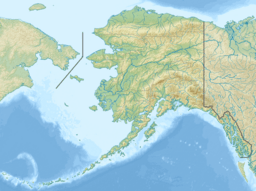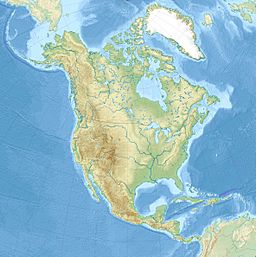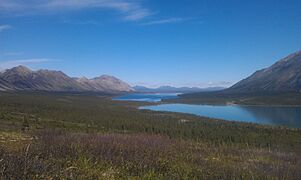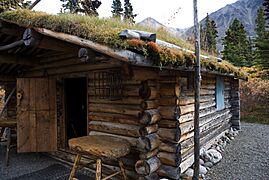Twin Lakes (Alaska) facts for kids
Quick facts for kids Twin Lakes |
|
|---|---|
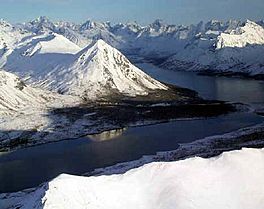 |
|
| Location | Lake and Peninsula Borough, Alaska |
| Coordinates | 60°38′20″N 153°51′47″W / 60.63889°N 153.86306°W |
| Basin countries | United States |
| Average depth | 987 ft (301 m) |
Twin Lakes is a pair of large, beautiful lakes located in Lake Clark National Park in Alaska. These two lakes are found in a very wild and quiet part of the state. They are famous for their stunning natural beauty and for being the home of a well-known naturalist.
Contents
Exploring Twin Lakes in Alaska
Twin Lakes is made up of two main bodies of water. There is a longer upper lake, which is about 6-mile-long (9.7 km). Then there is a smaller lower lake, which stretches for about 4-mile-long (6.4 km). A short stream connects these two lakes.
Where the Water Goes
The water from Twin Lakes flows westward into the Chilikadrotna River. From there, it travels into the Mulchatna River and then the Nushagak River. Finally, it reaches Nushagak Bay, which is part of the larger ocean.
Visiting Twin Lakes
Twin Lakes is a very remote place. This means it is far away from cities and towns. There are no people living there permanently. However, in the late summer, it becomes a popular spot for hunting. The only way to reach Twin Lakes is by air taxi. You can fly in on a plane with floats (for landing on water) or wheels (for landing on a small airstrip).
Richard Proenneke's Wilderness Home
Twin Lakes was the special home of a man named Richard Proenneke (1916–2003). He was a naturalist, which means he loved and studied nature. Richard spent most of the last 35 years of his life living alone at Twin Lakes. From 1968 to 1998, he lived in a log cabin that he built completely by hand.
A Life in the Wild
Richard Proenneke's story is very inspiring. He showed how one person could live simply and in harmony with nature. His experiences at Twin Lakes were shared in books and films. These include One Man's Wilderness: An Alaskan Odyssey and Alone in the Wilderness. His cabin is now a historic site, showing how he lived off the land.
Gallery


